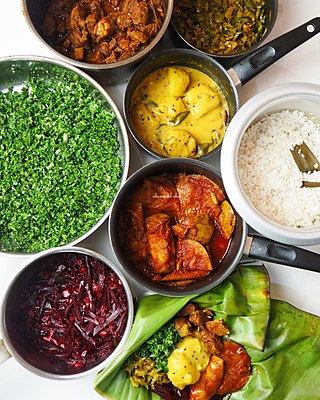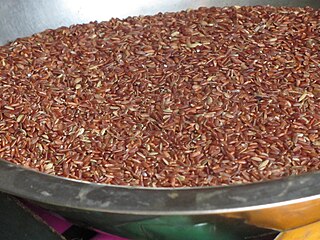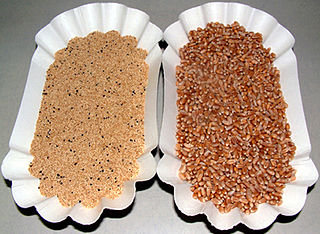
Rice in Sri Lanka has played an important role in the country's functioning and survival for centuries. Rice continues to be a staple of traditional Sri Lankan cuisine today.

Rice in Sri Lanka has played an important role in the country's functioning and survival for centuries. Rice continues to be a staple of traditional Sri Lankan cuisine today.
Sri Lankan people may have started cultivating rice as early as 800 B.C., according to documentary evidence. [1] Further evidence of early rice cultivation is the construction, since 390 B.C., of massive irrigation structures, reservoirs, and interconnected canals. From ancient times, rice cultivation was not only an economic activity, but a way of life for the people of Sri Lanka. [2] Some varieties of rice have been passed down for generations, and are called traditional, indigenous, or heirloom.
Once renowned as the granary of the east, Sri Lanka offered more than 2000 indigenous rice varieties to the rest of the world. Rice cultivation in Sri Lanka was once considered sacred. The process remained sustainable due to the methods used for production, as well as the sanctity associated with the process of rice cultivation. [3]
By the 1980s, 90% of the farmland in Sri Lanka was being used to cultivate the "semi-dwarf" (newly improved) rice variety.
Currently, 95% of the rice produced in Sri Lanka are hybrid varieties. These are harvested using non-organic fertilizer and pesticides which are needed to produce larger harvests with lower costs.
However, traditional rice is gradually making a comeback. This is due to increased global demand for organic food. [4] [5]
As the translated name implies, this is a fragrant white rice with an exquisite aroma. [6]
Its milky taste makes Suwandel a common choice for festive occasions and ceremonies. Nutritionally, the rice consists of 90% carbohydrates, 7% crude protein, 0.7% crude fat, and 0.1% crude fiber. Suwandel is known to contain higher amounts of glutamic acid and vitamins than other, more common rice varieties. [7]
Suwandel is an heirloom rice variety, cultivated organically with traditional rain-fed methods in the southern lowlands of Sri Lanka. Because of this, cultivation takes longer than other varieties of rice. It is usually 3 months before harvest. Heirloom rice cultivation in Sri Lanka is a sacred process.
Kalu Heenati is literally translated as "dark, fine grain." It is a highly nutritious red rice that is considered to be good for daily consumption. It contains a lot of medicinal properties. It is very good for lactating mothers. It enhances sexual potential and physical strength. [8]
This is a reddish-brown rice variety with a unique texture. It is low in carbohydrates, and rich in protein and fiber. Ma-Wee is also proven to have a 25% to 30% lower glycemic index (GI) than other common rice varieties. It is 84.5% carbohydrates, 9.4% protein, 3.6% fat, and 1.1% fiber.
Ma-Wee rice is best when soaked prior to boiling. One traditional dish calls for the rice to be cooked with chopped spring onion and leeks, and served with bottle gourd sautéed in spices and coconut milk.
Ma-Wee was loved by the queens of Sri Lanka, who believed it helped them maintain a trim, shapely figure.
Ma-Wee is also revered for its historical importance in religious ceremonies. According to folklore, Ma-Wee has been placed in the caskets of sacred relics and the pinnacle (kotha) of dagabas. [9]
The word "Pachchaperumal" means "The Lord Buddha’s color." It is a wholesome red rice variety. When cooked, it takes on a deep, rich burgundy color. It is rich in nutrients and proteins, and is considered an excellent choice for an every day meal. [10] It is also said to be part of a good diet for people with diabetes and cardiovascular disease.
Pachchaperumal has long been considered a divine rice in traditional Sinhalese culture. Traditionally, it was often used in alms-giving.

A nutritious red rice variety rich in proteins and fiber, kuruluthuda has a unique, pleasant taste.
This is also known as Olu Sahal. Olu rice is one of the staple foods of the Hela diet.
Other varieties include Rathdel, Madathawalu, and Hetadha Wee.
Rice has a sacred association among Buddhist, Hindu, and Muslim populations alike. It is said that rice cooked with coconut milk was the first offering made to Buddha, and to this day the dish is a staple of Sri Lankan Buddhist culture during sacred festivals and important events.

Sago is a starch extracted from the pith, or spongy core tissue, of various tropical palm stems, especially those of Metroxylon sagu. It is a major staple food for the lowland peoples of New Guinea and the Maluku Islands, where it is called saksak, rabia and sagu. The largest supply of sago comes from Southeast Asia, particularly Indonesia and Malaysia. Large quantities of sago are sent to Europe and North America for cooking purposes. It is traditionally cooked and eaten in various forms, such as rolled into balls, mixed with boiling water to form a glue-like paste (papeda), or as a pancake.

Fonio, also sometimes called findi or acha, is the term for two cultivated grasses in the genus Digitaria that are important crops in parts of West Africa. The nutritious food with a favorable taste is a vital food source in many rural areas, especially in the mountains of Fouta Djalon, Guinea but it is also cultivated in Mali, Burkina Faso, Ivory Coast, Nigeria, and Senegal. The global fonio market was estimated at 721,400 tonnes in 2020. Guinea annually produces the most fonio in the world, accounting for over 75% of the world's production in 2019. The name fonio is from Wolof foño. In West Africa, the species black fonio (Digitaria iburua) and white fonio (Digitaria exilis) are cultivated; the latter is the economically more important crop.

Ullucus is a genus of flowering plants in the family Basellaceae, with one species, Ullucus tuberosus, a plant grown primarily as a root vegetable, secondarily as a leaf vegetable. The name ulluco is derived from the Quechua word ulluku, but depending on the region, it has many different names. These include illaco, melloco, chungua or ruba, olluco or papalisa, or ulluma.

Nelumbo nucifera, also known as sacred lotus, Indian lotus, or simply lotus, is one of two extant species of aquatic plant in the family Nelumbonaceae. It is sometimes colloquially called a water lily, though this more often refers to members of the family Nymphaeaceae.

Basmati, pronounced['bɑːsmət̪iː], is a variety of long, slender-grained aromatic rice which is traditionally grown in the Indian subcontinent, mainly Bangladesh, India, Pakistan, Sri Lanka and Nepal. As of 2019, India accounted for 65% of the international trade in basmati rice, while Pakistan accounted for the remaining 35%. Many countries use domestically grown basmati rice crops; however, basmati is geographically exclusive to certain districts of India and Pakistan.

Sri Lankan cuisine is known for its particular combinations of herbs, spices, fish, vegetables, rices, and fruits. The cuisine is highly centered around many varieties of rice, as well as coconut which is a ubiquitous plant throughout the country. Seafood also plays a significant role in the cuisine, be it fresh fish or preserved fish. As a country that was a hub in the historic oceanic silk road, contact with foreign traders brought new food items and cultural influences in addition to the local traditions of the country's ethnic groups, all of which have helped shape Sri Lankan cuisine. Influences from Indian, Indonesian and Dutch cuisines are most evident with Sri Lankan cuisine sharing close ties to other neighbouring South and Southeast Asian cuisines.

The asparagus bean is a legume cultivated for its edible green pods containing immature seeds, like the green bean. It is also known as: yardlong bean, pea bean, long-podded cowpea, Chinese long bean, snake bean, bodi, and bora. Despite the common name of "yardlong", the pods are actually only about half a yard long, so the subspecies name sesquipedalis is a more accurate approximation.

Digitaria exilis, referred to as findi or fundi in areas of Africa, such as The Gambia, with English common names white fonio, fonio millet, and hungry rice or acha rice, is a grass species. It is the most important of a diverse group of wild and domesticated Digitaria species known as fonio that are harvested in the savannas of West Africa. The grains are very small. It has potential to improve nutrition, boost food security, foster rural development and support sustainable use of the land. Despite its valuable characteristics and widespread cultivation, fonio has generally received limited research and development attention, which is also why the species is sometimes referred to as an underutilized crop.

North Western Province is a province of Sri Lanka. It is the fourth-largest province by land area, covering 7,888 km2 (3,046 sq mi), and the fourth-most populated province with a population of over 2,592,000 people. North Western Province is bordered by the North Central Province, Sri Lanka to the north, Central Province, Sri Lanka to the east, Sabaragamuwa Province to the southeast, Western Province, Sri Lanka to the south, and is bounded by the Indian Ocean to the west.

The culture of Sri Lanka mixes modern elements with traditional aspects and is known for its regional diversity. Sri Lankan culture has long been influenced by the heritage of Theravada Buddhism passed on from India, and the religion's legacy is particularly strong in Sri Lanka's southern and central regions. South Indian cultural influences are especially pronounced in the northernmost reaches of the country. The history of colonial occupation has also left a mark on Sri Lanka's identity, with Portuguese, Dutch, and British elements having intermingled with various traditional facets of Sri Lankan culture. Additionally, Indonesian culture has also influenced certain aspects of Sri Lankan culture. Culturally, Sri Lanka possesses strong links to both India and Southeast Asia. For over 2,500 years, India and Sri Lanka have nurtured a legacy of historical, cultural, religious, spiritual, and linguistic connections.

Red rice is rice that is colored red due to natural anthocyanin content. It is usually eaten unpolished or partially polished, and has a red bran layer, rather than the more common pale brown. Red rice has a nutty flavor. It has the highest nutritional value among rices eaten with the bran intact.

Species belonging to the genus Amaranthus have been cultivated for their grains for 8,000 years. Amaranth plants are classified as pseudocereals that are grown for their edible starchy seeds, but they are not in the same botanical family as true cereals, such as wheat and rice. Amaranth species that are still used as a grain are Amaranthus caudatus L., Amaranthus cruentus L., and Amaranthus hypochondriacus L. The yield of grain amaranth is comparable to that of rice or maize.

The primary form of agriculture in Sri Lanka is rice production. Rice is cultivated during Maha and Yala seasons. Tea is cultivated in the central highlands and is a major source of foreign exchange. Vegetables, fruits and oilseed crops are also cultivated in the country. There are two Agriculture Parks abbreviated as A. Parks established by the Department of Agriculture. Out of the total population in Sri Lanka, 27.1% engages in agricultural activities. Agriculture accounted for 7.4% of the GDP in 2020.

Kiribath is a traditional Sri Lankan dish made from rice. It is prepared by cooking rice with coconut milk, hence this name, and can be considered a form of rice cake or rice pudding. Kiribath is an essential dish in Sri Lankan cuisine. It is very commonly served for breakfast on the first day of each month and also has the added significance of being eaten for any auspicious moment throughout one's lifetime which are marking times of transition. It is one of the more renowned traditional dishes in Sri Lanka.

Pokkali is a unique saline tolerant rice variety that is cultivated using extensive aquaculture in an organic way in the water-logged coastal regions, spread in about 5000 hectares area in Alappuzha, Kottayam, Thrissur and Ernakulam districts of Kerala in Southern India. The brand Pokkali has received a GI tag from the Geographical Indications Registry Office, Chennai.

A grain is a small, hard, dry fruit (caryopsis) – with or without an attached hull layer – harvested for human or animal consumption. A grain crop is a grain-producing plant. The two main types of commercial grain crops are cereals and legumes.

Ancient grains is a marketing term used to describe a category of grains and pseudocereals that are purported to have been minimally changed by selective breeding over recent millennia, as opposed to more widespread cereals such as corn, rice and modern varieties of wheat, which are the product of thousands of years of selective breeding. Ancient grains are often marketed as being more nutritious than modern grains, though their health benefits over modern varieties have been disputed by some nutritionists.

Hemp juice is a beverage derived from industrial hemp, made from the result of pressing the Cannabis sativa plant. The juice is obtained through a large-scale industrial cold-pressing procedure using the upper parts of the hemp plant as well as the leaves. This procedure distinguishes hemp juice from other hemp products such as hemp oil, hemp sprouts or hemp milk, which are obtained through the seeds of the hemp plant.

Rice production or Paddy production is one of the main productions and staple foods in Sri Lanka. It cultivates in all districts of Sri Lanka during two monsoon seasons. It is estimated that about 708,000 ha of land uses for paddy. The seasons are called Maha season and Yala season. Maha Season starts by September and ends by March during North-east monsoon, and Yala season starts by May and ends by August.
The Future 50 Foods report, subtitled "50 foods for healthier people and a healthier planet", was published in February 2019 by the World Wide Fund for Nature (WWF) and Knorr. It identifies 50 plant-based foods that can increase dietary nutritional value and reduce environmental impacts of the food supply, promoting sustainable global food systems.